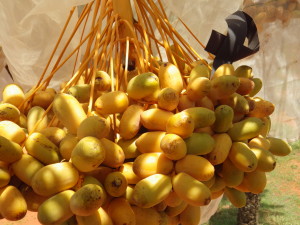 Growing dates is a labour intensive process!
Growing dates is a labour intensive process!
Below is a gallery which shows some of the steps in the process – we will be adding photos as we take more!
Dates are dioacious which means there is a male and female palm. Our season starts in about September when the male and female flowers start to emerge. We collect the pollen from the male flowers and use it to hand pollinate the female flowers.
Growing bunches are thinned to ensure quality fruit. The thinning process also give us a chance to visit each tree and de-thorn the fronds. Date thorns are up to 100mm long and will easily puncture a tyre so cutting them off is a big part of making it safe to work in the palms! We also tie each bunch of fruit down to a nearby frond to prevent the stem from breaking under the weight of the fruit and and bag it to stop the ring neck parrots and galahs from destroying them.
The palms are pruned once the fruit is bagged as more energy goes into fruit production and the lower fronds die off.
Our harvest usually starts in mid February and can continue through until early May. Some varieties such as medjool and barhee require dates to be individually picked whereas others (like the Zahidi and Thoory) can be picked a strand at a time. Very soft varieties need to be dried before we can pack them into boxes. This year we will be using a solar drying system to achieve better consistency in the drying process. All of our fruit is hand graded to ensure high quality is maintained.
Once the harvest is finished and the dates are sold there is quite a lot of cleaning up to do in the plantation. All the old flower stems are cut out and we prune again to keep good air flow in the canopy.
Fertilising and spraying for parlatoria scale are undertaken opportunistically throughout the year.











